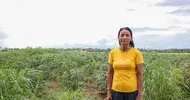
FCC estimates that nine to 15 per cent of farmland purchases are by businesses, investors or others who don’t intend to farm themselves. (Photo: Stephane Hachey/iStock/Getty Images)
Farmland is selling, but who’s paying the higher prices?
by Jeff Melchior
Farmland prices continue to rise across Canada, but who’s paying them? Not only farmers, says Farm Credit Canada’s chief economist.
Farmland prices continue to rise across Canada, but who’s paying them? Not only farmers, says Farm Credit Canada’s chief economist.
“We think there’s between nine to 15 per cent of (farmland) transactions that are purchases made by non-traditional buyers. That’s significant,” J.P. Gervais told an online news conference last month.
Who are these non-traditional buyers?
“They own businesses, corporations and so forth that are buying land without the intent of farming it. They’re buying land to lease it,” he said.
However, FCC’s methodologies can’t verify the exact percentage of their purchases. Gervais said the nine to 15 per cent figure is a best guess. But these purchases are affecting farmland values, particularly on a local level.
“The presence of these buyers in the market is very local. It might be that in (particular areas) it’s quite significant. Even if the non-traditional buyer doesn’t end up buying the land, the mere presence of this buyer actually changes the dynamics between buyers and sellers and that has an impact we’re not able to estimate.”
Most farmland transactions are between farm operations, Gervais said. However, the presence of non-traditional buyers bears watching.
“There’s definitely an impact. It’s something to monitor going forward and hopefully, we can get a little more data over the years to understand what’s going on in this trend in the marketplace.”
Gervais’ comments come on the heels of FCC’s farmland values report for 2022 in March, which revealed that elevated interest and input costs had little (or at least delayed) effect on rising land values.
The average value of Canadian farmland increased by nearly 13 per cent (10 per cent in Alberta) in 2022, the highest such increase since 2014. It follows gains of just over eight per cent in 2021 and 5.4 per cent in 2020.
This was the opposite of what Gervais predicted would happen in 2022, when he expected the rate of increase to be smaller than that in 2021.
“At this exact same time a year ago, I said that I expected the rate of increase to be smaller than the 2021 rate of increase. Up until very recently, I did not think that we were going to get 12.8 per cent.”
The influence of non-traditional farm buyers speaks to the bigger issue of farmland supply, a factor Gervais said will require more attention in the future.
“Looking at this year overall, the economic environment and how it generated the results we have in front of us, I think supply plays a little bit bigger role than we’ve normally acknowledged in the past.”
Area is declining
There’s evidence that Canada is losing farmland, or at least farmland that is actually farmed. In some regions this trend is significant, said Gervais.
“If you look at the census data in Canada looking back at the last 10 years, we lost farmed areas in each of the provinces. In some of the Atlantic Canada provinces we’ve lost quite a significant large amount of farmland that is farmed.
“Quebec and Ontario lost about five per cent of farmed area. In the Prairie provinces, a little bit more. But nonetheless we’ve lost a little bit so that would explain as well the tight supply of land that is available.”
Statistics Canada reported a total Alberta farm area of just over 49 million acres in 2021, second only to Saskatchewan.
That number represents a decrease of just over two per cent since 2016, with most of that drop coming from loss of natural and seeded land for pasture, woodlands, wetlands and summerfallow area. Cropland increased from 2016 to 2021.
Supply is a farmland value factor that’s difficult to quantify, said Gervais.
“We’re never going to be able — even with our data set — to tell the story about supply. What we know is that when there is land available and because supply is really tight, it doesn’t take many buyers to create this competition for land, which results in some of the prices that we’re seeing today.
“I think the availability of land for sale is definitely one of the drivers behind the results we’re reporting for 2022.”












